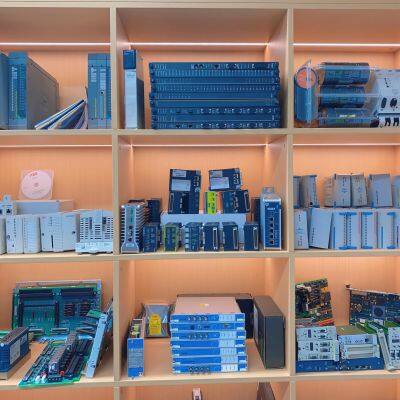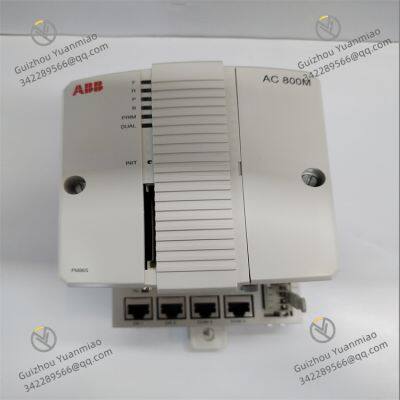Product Description
I. Overview
ABB PM865 3BSE030193R1 is a high-performance central processing unit module, belonging to the ABB AC800M series of control systems. This series of control systems is widely used in the field of industrial automation, and PM865, as a core component within it, undertakes key tasks such as data processing, logical control, and system coordination.
With its powerful computing capability and stable performance, it can meet the control requirements of various complex industrial scenarios, such as large-scale production equipment and process control in industries like chemical engineering, electric power, metallurgy, and water treatment. By working in collaboration with other modules in the AC800M series (such as I/O modules and communication modules), it can build an efficient and reliable automated control system, realizing precise monitoring and intelligent management of the production process, and providing a solid guarantee for the safe, stable, and efficient operation of industrial production.

II. Technical Parameters
Processor: It adopts a high-performance processor with a clock frequency usually at the level of several hundred megahertz. It has strong data processing and computing capabilities, and can quickly execute complex control algorithms and logical programs, ensuring real-time response to industrial production processes.
Memory Configuration: It is equipped with a relatively large capacity of memory, including Random Access Memory (RAM) and Flash memory. The RAM capacity is generally several hundred megabytes, used for temporarily storing data and intermediate results during program operation; the Flash capacity usually also reaches several hundred megabytes, used for storing the operating system, user programs, configuration files, etc., ensuring that the system can start quickly and run stably after being powered on.
Communication Interfaces:
It integrates multiple Ethernet interfaces, supporting speeds such as 10/100/1000Base-T, which can realize high-speed data communication with upper computers, other controllers, and network devices. It supports network protocols such as TCP/IP and UDP, meeting the system's requirements for remote monitoring and data transmission.
It may include dedicated fieldbus interfaces, such as PROFIBUS DP and Modbus, facilitating communication with on-site equipment such as sensors, actuators, and frequency converters, enabling data collection and the issuance of control commands.
Power Requirements: It usually uses DC power supply, with an input voltage range generally of 24V DC (±10%). It has low power consumption, which is usually several watts under normal working conditions, without imposing excessive burden on the system power supply. At the same time, it is equipped with overvoltage and undervoltage protection functions to ensure the stable operation of the module when the power supply fluctuates.
Working Environment: The operating temperature range is generally 0 - 60℃, which can adapt to different temperature conditions in industrial sites; the relative humidity is usually 5% - 95% (no condensation), with a certain moisture-proof capability; it can withstand a certain degree of vibration and impact, meeting the reliability requirements of industrial environments.
Programming Language Support: It supports multiple mainstream industrial programming languages, such as Ladder Diagram (LD), Function Block Diagram (FBD), Structured Text (ST), and Sequential Function Chart (SFC), which is convenient for engineers to develop and write programs according to actual needs, improving programming efficiency and flexibility.

III. Functional Features
Powerful Computing and Control Capability: Thanks to the high-performance processor and sufficient memory resources, PM865 can quickly process a large amount of real-time data and efficiently execute complex control logic and algorithms. Whether it is continuous process control or discrete control, it can be accurately realized, meeting the high requirements for control precision and response speed in industrial production, and ensuring the stable operation of the production process.
Excellent Communication Capability: With rich communication interfaces and support for multiple communication protocols, it can be easily integrated into various industrial network architectures. It can seamlessly connect and exchange data with equipment and systems from different manufacturers, realizing information sharing and collaborative control. At the same time, it supports redundant communication configurations, improving communication reliability and avoiding system interruptions caused by a single communication link failure.
High Reliability and Stability: It uses industrial-grade components and strict production processes, and has undergone rigorous environmental testing and reliability verification. It has strong anti-electromagnetic interference capability and can work stably in the complex electromagnetic environment of industrial sites. In addition, it supports hot-swap functionality, allowing the module to be replaced during system operation without affecting the normal operation of the entire system, greatly improving system availability and maintenance convenience.
Flexible Expandability: As part of the AC800M series, PM865 can be flexibly expanded with various I/O modules, communication modules, etc. in the series. Users can conveniently add or reduce modules according to the actual control scale and functional requirements, building a control system that meets specific application scenarios. It has strong adaptability and expandability, and can be upgraded and expanded as production needs change.
Convenient Programming and Debugging: Equipped with ABB's dedicated programming software (such as Control Builder M), it provides an intuitive and user-friendly development environment. Engineers can develop programs using multiple programming languages, and the software has rich debugging tools and diagnostic functions, which can quickly locate and solve errors in the program, improving development efficiency and shortening the system debugging cycle.

IV. Common Faults and Solutions
Module Failure to Start or Abnormal Start
Fault Phenomenon: After the module is powered on, the indicator light is not on or displays abnormally, it cannot enter the working state normally, and the system reports a module fault.
Possible Causes: Power supply issues, such as unstable supply voltage, poor contact of the power interface, or failure of the power module; damage or loss of the internal firmware of the module; hardware faults of the module, such as damage to key components like the processor and memory.
Solutions: First, check the power supply, use a multimeter to measure whether the input voltage is within the specified range, check whether the power interface is firmly connected, and replace the power module for testing if necessary. If the power supply is normal, try to reload the module firmware program. If the problem remains unsolved, it may be a module hardware fault, and it is necessary to contact ABB professional maintenance personnel for repair or replacement of the module.
Communication Fault
Fault Phenomenon: The module cannot communicate normally with other equipment and systems, with data transmission interrupted, delayed, or incorrect, and the communication indicator light is in an abnormal state.
Possible Causes: Communication line faults, such as damaged network cables, fieldbus cables, poor contact, or incorrect wiring; incorrect configuration of communication protocols, such as incorrect settings of parameters like IP address, port number, and baud rate; hardware faults of the communication interface; strong electromagnetic interference in the network.
Solutions: Check whether the communication line connections are firm, whether the cables are damaged, re-plug or replace the communication line for testing. Verify the communication protocol parameter configuration to ensure it is consistent with the parameters of the communicating counterpart device. Use the replacement method to check if the communication interface is faulty; if the interface is damaged, the module needs to be repaired or replaced. For electromagnetic interference issues, measures such as adding shielding layers, keeping away from interference sources, and optimizing wiring can be taken to reduce the impact of interference.
Abnormal Program Operation
Fault Phenomenon: The control program executes incorrectly, with logical confusion, abnormal control actions, etc., leading to unstable production processes or failure to meet expectations.
Possible Causes: Errors in program writing, such as logical loopholes and incorrect instructions; unreasonable setting of program parameters; memory faults of the module, leading to data loss or errors during program operation; external interference affecting the normal execution of the program.
Solutions: Use programming software to conduct a comprehensive inspection and debugging of the control program, find and fix errors in the program. Recheck and adjust program parameters to ensure they meet actual control requirements. Test the module memory, and replace it in time if there is a fault. Take anti-interference measures, such as strengthening grounding and adding shielding, to reduce the impact of external interference on program operation.
Frequent Offline or Communication Interruption of the Module
Fault Phenomenon: The module frequently goes offline during operation, and communication with other equipment is interrupted irregularly, affecting the normal monitoring and control of the system.
Possible Causes: Unstable communication links, such as poor contact of network cables, failure of network switches; poor heat dissipation of the module, leading to excessive working temperature and affecting communication stability; poor contact between the module and the rack, resulting in unstable electrical connections.
Solutions: Check the communication link, re-plug the network cable, check the working status of the network switch, and replace the switch or network cable if necessary. Check the heat dissipation of the module, clean the dust on the module surface and heat dissipation holes to ensure good heat dissipation and avoid excessive temperature. Pull the module out of the rack and reinsert it to ensure tight and firm contact between the module and the rack; if necessary, check whether there is a fault in the rack interface.


EMERSON 5X00790G01 Compact Controller
EMERSON 5X00453G01 Power Supply Module
EMERSON 5X00846G01 8 Channel Analog Input Module
Honeywell 51454926-176 Safety Controller Module
WOODWARD BUM60-1224-54-B-001-VC-A0-0093-0013-G003-000 Controller
GE VPROH2B IS215VPROH2BC Emergency Turbine Protection Card
GE DS2020PDMAG6 Power Distribution Module
GE IS200AEPCH1ABC Crucial Printed Circuit Board
GE IS210MACCH2AEG Printed Circuit Board
GE IS210MACCH1AGG Single-Axis Motion Control Module
GE IS210MACCH2AGG Analog Output Module
GE IS200AEPCH1BAA Circuit Board
 yezi
Hi there! Welcome to my shop. Let me know if you have any questions.
yezi
Hi there! Welcome to my shop. Let me know if you have any questions.





